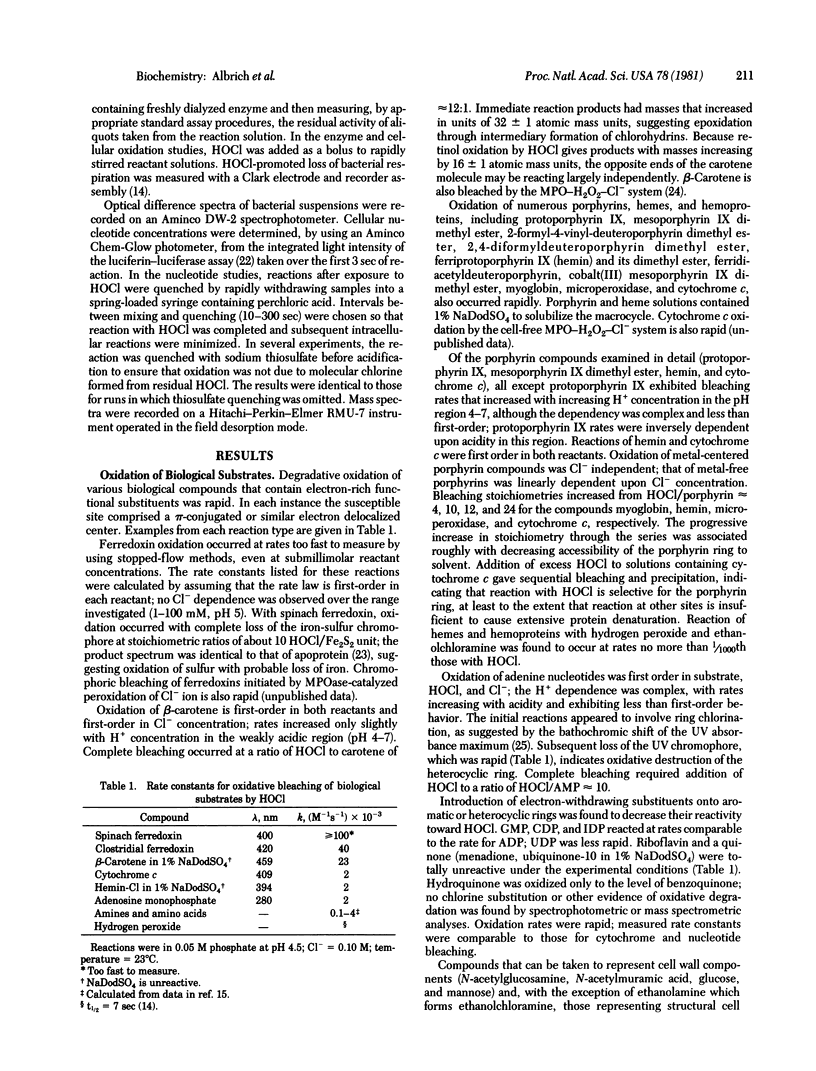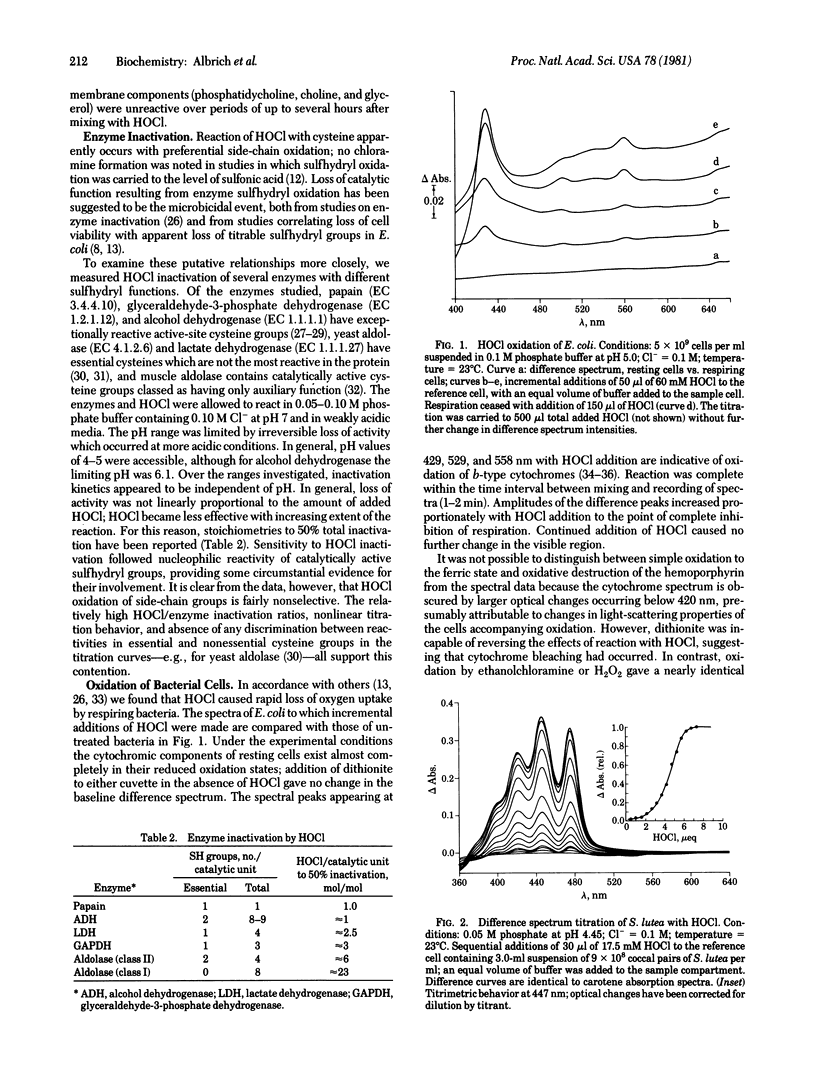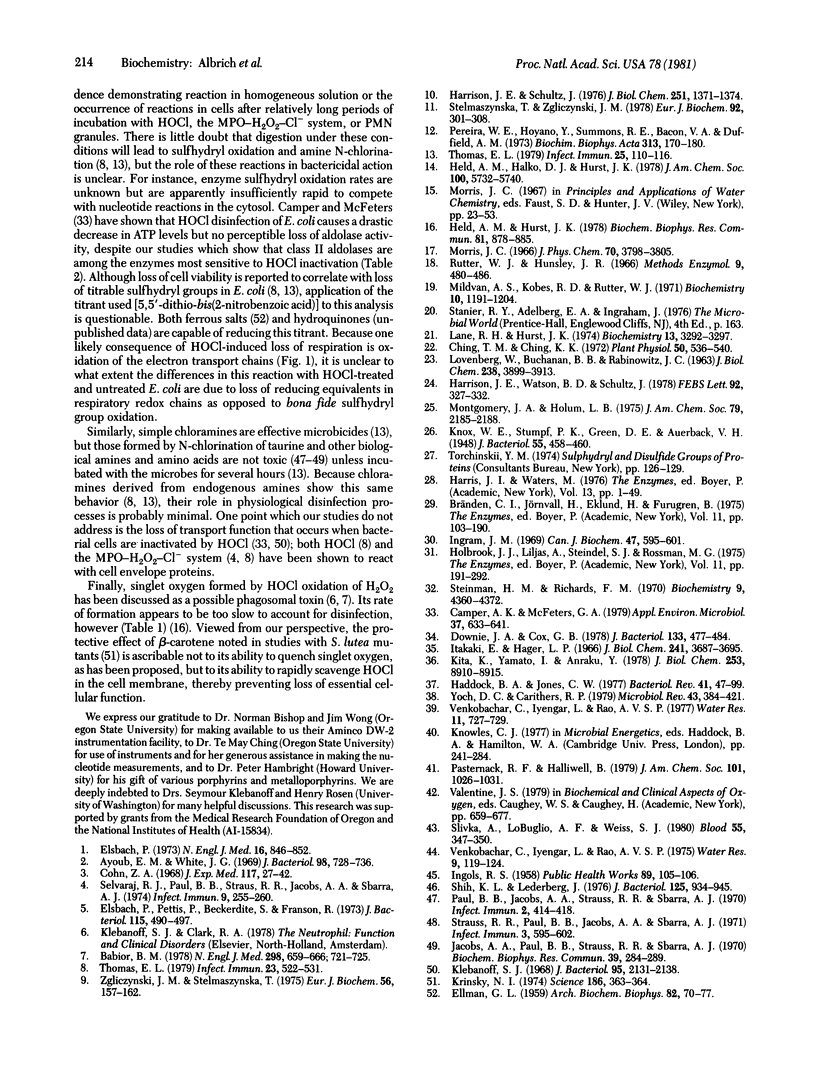Abstract
Oxidative degradation of biological substrates by hypochlorous acid has been examined under reaction conditions similar to those found in active phagosomes. Iron sulfur proteins are bleached extremely rapidly, followed in decreasing order by beta-carotene, nucleotides, porphyrins, and heme proteins. Enzymes containing essential cysteine molecules are inactivated with an effectiveness that roughly parallels the nucleophilic reactivities of their sulfhydryl groups. Other compounds, including glucosamines, quinones, riboflavin, and, except for N-chlorination, phospholipids, are unreactive. Rapid irreversible oxidation of cytochromes, adenine nucleotides, and carotene pigments occurs when bacterial cells are exposed to exogenous hypochlorous acid; with Escherichia coli, titrimetric oxidation of cytochrome was found to coincide with loss of aerobic respiration. The occurrence of these cellular reactions implicates hypochlorous acid as a primary microbicide in myeloperoxidase-containing leukocytes; the reactivity patterns observed are consistent with the view that bactericidal action results primarily from loss of energy-linked respiration due to destruction of cellular electron transport chains and the adenine nucleotide pool.
Full text
PDF




Selected References
These references are in PubMed. This may not be the complete list of references from this article.
- Ayoub E. M., White J. G. Intraphagocytic degradation of group A streptococci: electron microsopic studies. J Bacteriol. 1969 May;98(2):728–736. doi: 10.1128/jb.98.2.728-736.1969. [DOI] [PMC free article] [PubMed] [Google Scholar]
- Babior B. M. Oxygen-dependent microbial killing by phagocytes (first of two parts). N Engl J Med. 1978 Mar 23;298(12):659–668. doi: 10.1056/NEJM197803232981205. [DOI] [PubMed] [Google Scholar]
- COHN Z. A. The fate of bacteria within phagocytic cells. I. The degradation of isotopically labeled bacteria by polymorphonuclear leucocytes and macrophages. J Exp Med. 1963 Jan 1;117:27–42. doi: 10.1084/jem.117.1.27. [DOI] [PMC free article] [PubMed] [Google Scholar]
- Camper A. K., McFeters G. A. Chlorine injury and the enumeration of waterborne coliform bacteria. Appl Environ Microbiol. 1979 Mar;37(3):633–641. doi: 10.1128/aem.37.3.633-641.1979. [DOI] [PMC free article] [PubMed] [Google Scholar]
- Ching T. M., Ching K. K. Content of adenosine phosphates and adenylate energy charge in germinating ponderosa pine seeds. Plant Physiol. 1972 Nov;50(5):536–540. doi: 10.1104/pp.50.5.536. [DOI] [PMC free article] [PubMed] [Google Scholar]
- Downie J. A., Cox G. B. Sequence of b cytochromes relative to ubiquinone in the electron transport chain of Escherichia coli. J Bacteriol. 1978 Feb;133(2):477–484. doi: 10.1128/jb.133.2.477-484.1978. [DOI] [PMC free article] [PubMed] [Google Scholar]
- ELLMAN G. L. Tissue sulfhydryl groups. Arch Biochem Biophys. 1959 May;82(1):70–77. doi: 10.1016/0003-9861(59)90090-6. [DOI] [PubMed] [Google Scholar]
- Elsbach P. On the interaction between phagocytes and micro-organisms. N Engl J Med. 1973 Oct 18;289(16):846–852. doi: 10.1056/NEJM197310182891610. [DOI] [PubMed] [Google Scholar]
- Elsbach P., Pettis P., Beckerdite S., Franson R. Effects of phagocytosis by rabbit granulocytes on macromolecular synthesis and degradation in different species of bacteria. J Bacteriol. 1973 Aug;115(2):490–497. doi: 10.1128/jb.115.2.490-497.1973. [DOI] [PMC free article] [PubMed] [Google Scholar]
- Haddock B. A., Jones C. W. Bacterial respiration. Bacteriol Rev. 1977 Mar;41(1):47–99. doi: 10.1128/br.41.1.47-99.1977. [DOI] [PMC free article] [PubMed] [Google Scholar]
- Harrison J. E., Schultz J. Studies on the chlorinating activity of myeloperoxidase. J Biol Chem. 1976 Mar 10;251(5):1371–1374. [PubMed] [Google Scholar]
- Harrison J. E., Watson B. D., Schultz J. Myeloperoxidase and singlet oxygen: a reappraisal. FEBS Lett. 1978 Aug 15;92(2):327–332. doi: 10.1016/0014-5793(78)80780-7. [DOI] [PubMed] [Google Scholar]
- Held A. M., Hurst J. K. Ambiguity associated with use of singlet oxygen trapping agents in myeloperoxidase-catalyzed oxidations. Biochem Biophys Res Commun. 1978 Apr 14;81(3):878–885. doi: 10.1016/0006-291x(78)91433-x. [DOI] [PubMed] [Google Scholar]
- Ingram J. M. Fructose diphosphate aldolase of yeast: studies on the sulfhydryl groups. Can J Biochem. 1969 Jun;47(6):595–601. doi: 10.1139/o69-094. [DOI] [PubMed] [Google Scholar]
- Itagaki E., Hager L. P. Studies on cytochrome b-562 of Escherichia coli. I. Purification and crystallization of cytochrome b-562. J Biol Chem. 1966 Aug 25;241(16):3687–3695. [PubMed] [Google Scholar]
- Jacobs A. A., Paul B. B., Strauss R. R., Sbarra A. J. The role of the phagocyte in host-parasite interactions. 23. Relation of bactericidal activity to peroxidase-associated decarboxylation and deamination. Biochem Biophys Res Commun. 1970 Apr 24;39(2):284–289. doi: 10.1016/0006-291x(70)90791-6. [DOI] [PubMed] [Google Scholar]
- Kita K., Yamato I., Anraku Y. Purification and properties of cytochrome b556 in the respiratory chain of aerobically grown Escherichia coli K12. J Biol Chem. 1978 Dec 25;253(24):8910–8915. [PubMed] [Google Scholar]
- Klebanoff S. J. Myeloperoxidase-halide-hydrogen peroxide antibacterial system. J Bacteriol. 1968 Jun;95(6):2131–2138. doi: 10.1128/jb.95.6.2131-2138.1968. [DOI] [PMC free article] [PubMed] [Google Scholar]
- Knox W. E., Stumpf P. K., Green D. E., Auerbach V. H. The Inhibition of Sulfhydryl Enzymes as the Basis of the Bactericidal Action of Chlorine. J Bacteriol. 1948 Apr;55(4):451–458. [PMC free article] [PubMed] [Google Scholar]
- Krinsky N. I. Singlet excited oxygen as a mediator of the antibacterial action of leukocytes. Science. 1974 Oct 25;186(4161):363–365. doi: 10.1126/science.186.4161.363. [DOI] [PubMed] [Google Scholar]
- LOVENBERG W., BUCHANAN B. B., RABINOWITZ J. C. STUDIES ON THE CHEMICAL NATURE OF CLOSTRIDIAL FERREDOXIN. J Biol Chem. 1963 Dec;238:3899–3913. [PubMed] [Google Scholar]
- Lane R. H., Hurst J. K. Intermediates in enolase-catalyzed reactions. Biochemistry. 1974 Jul 30;13(16):3292–3297. doi: 10.1021/bi00713a018. [DOI] [PubMed] [Google Scholar]
- Lu Shih K., Lederberg J. Effects of chloramine on Bacillus subtilis deoxyribonucleic acid. J Bacteriol. 1976 Mar;125(3):934–945. doi: 10.1128/jb.125.3.934-945.1976. [DOI] [PMC free article] [PubMed] [Google Scholar]
- Mildvan A. S., Kobes R. D., Rutter W. J. Magnetic resonance studies of the role of the divalent cation in the mechanism of yeast aldolase. Biochemistry. 1971 Mar 30;10(7):1191–1204. doi: 10.1021/bi00783a016. [DOI] [PubMed] [Google Scholar]
- Paul B. B., Jacobs A. A., Strauss R. R., Sbarra A. J. Role of the Phagocyte in Host-Parasite Interactions XXIV. Aldehyde Generation by the Myeloperoxidase-H(2)O(2)-Chloride Antimicrobial System: a Possible In Vivo Mechanism of Action. Infect Immun. 1970 Oct;2(4):414–418. doi: 10.1128/iai.2.4.414-418.1970. [DOI] [PMC free article] [PubMed] [Google Scholar]
- Pereira W. E., Hoyano Y., Summons R. E., Bacon V. A., Duffield A. M. Chlorination studies. II. The reaction of aqueous hypochlorous acid with alpha-amino acids and dipeptides. Biochim Biophys Acta. 1973 Jun 20;313(1):170–180. doi: 10.1016/0304-4165(73)90198-0. [DOI] [PubMed] [Google Scholar]
- Selvaraj R. J., Paul B. B., Strauss R. R., Jacobs A. A., Sbarra A. J. Oxidative peptide cleavage and decarboxylation by the MPO-H2O2-Cl- antimicrobial system. Infect Immun. 1974 Feb;9(2):255–260. doi: 10.1128/iai.9.2.255-260.1974. [DOI] [PMC free article] [PubMed] [Google Scholar]
- Slivka A., LoBuglio A. F., Weiss S. J. A potential role for hypochlorous acid in granulocyte-mediated tumor cell cytotoxicity. Blood. 1980 Feb;55(2):347–350. [PubMed] [Google Scholar]
- Steinman H. M., Richards F. M. Participation of cysteinyl residues in the structure and function of muscle aldolase. Characterization of mixed disulfide derivatives. Biochemistry. 1970 Oct 27;9(22):4360–4372. doi: 10.1021/bi00824a017. [DOI] [PubMed] [Google Scholar]
- Stelmaszyńska T., Zgliczynski J. M. N-(2-Oxoacyl)amino acids and nitriles as final products of dipeptide chlorination mediated by the myeloperoxidase/H2O2/Cl- system. Eur J Biochem. 1978 Dec 1;92(1):301–308. doi: 10.1111/j.1432-1033.1978.tb12748.x. [DOI] [PubMed] [Google Scholar]
- Strauss R. R., Paul B. B., Jacobs A. A., Sbarra A. J. Role of the Phagocyte in Host-Parasite Interactions XXVII. Myeloperoxidase-H(2)O(2)-Cl-Mediated Aldehyde Formation and Its Relationship to Antimicrobial Activity. Infect Immun. 1971 Apr;3(4):595–602. doi: 10.1128/iai.3.4.595-602.1971. [DOI] [PMC free article] [PubMed] [Google Scholar]
- Thomas E. L. Myeloperoxidase, hydrogen peroxide, chloride antimicrobial system: nitrogen-chlorine derivatives of bacterial components in bactericidal action against Escherichia coli. Infect Immun. 1979 Feb;23(2):522–531. doi: 10.1128/iai.23.2.522-531.1979. [DOI] [PMC free article] [PubMed] [Google Scholar]
- Thomas E. L. Myeloperoxidase-hydrogen peroxide-chloride antimicrobial system: effect of exogenous amines on antibacterial action against Escherichia coli. Infect Immun. 1979 Jul;25(1):110–116. doi: 10.1128/iai.25.1.110-116.1979. [DOI] [PMC free article] [PubMed] [Google Scholar]
- Yoch D. C., Carithers R. P. Bacterial iron-sulfur proteins. Microbiol Rev. 1979 Sep;43(3):384–421. doi: 10.1128/mr.43.3.384-421.1979. [DOI] [PMC free article] [PubMed] [Google Scholar]
- Zgliczyński J. M., Stelmaszyńska T. Chlorinating ability of human phagocytosing leucocytes. Eur J Biochem. 1975 Aug 1;56(1):157–162. doi: 10.1111/j.1432-1033.1975.tb02218.x. [DOI] [PubMed] [Google Scholar]


